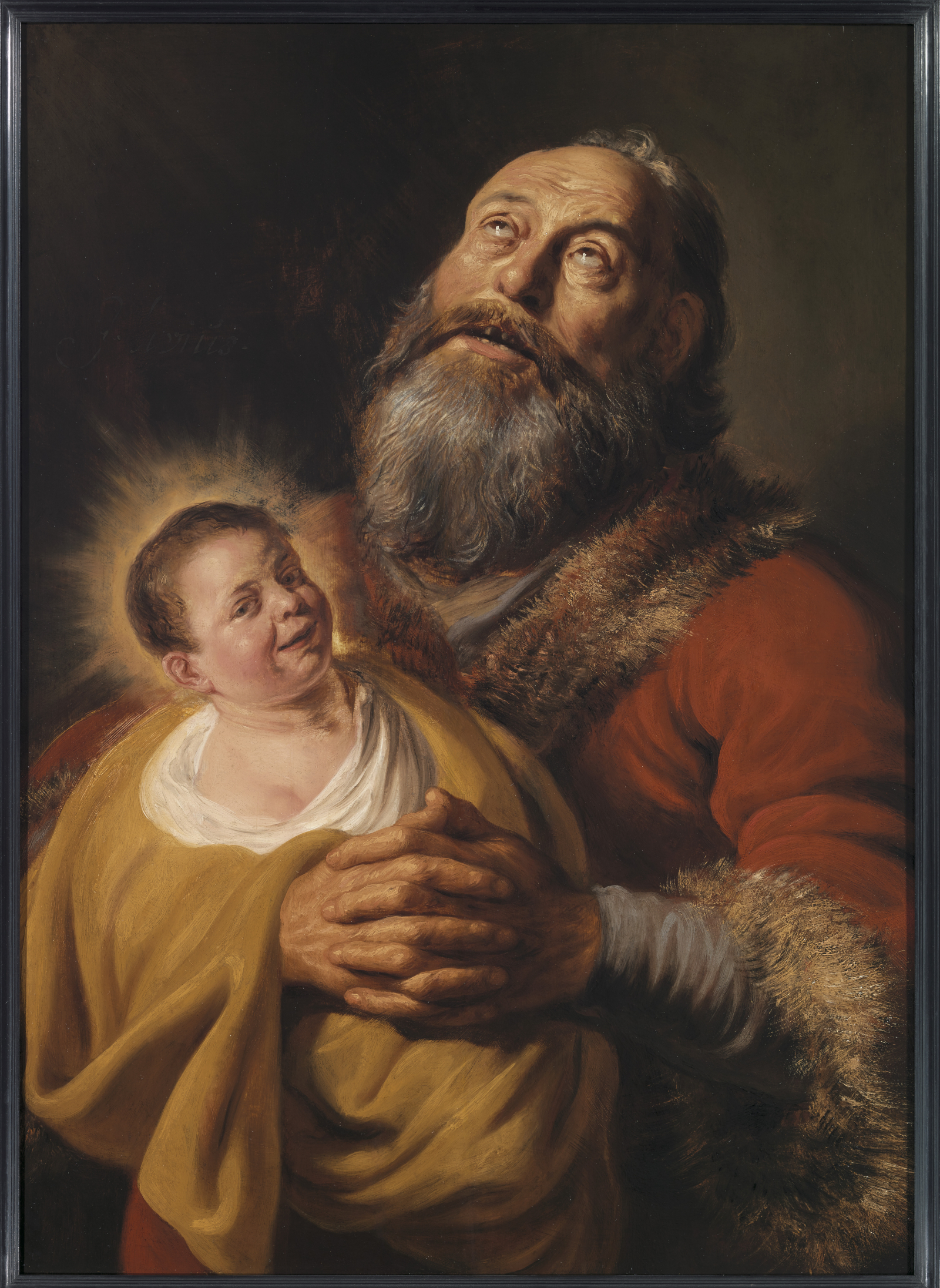Jan Lievens 1607-1674
Saint Simeon and the Christ Child
Signed upper left J. Liviús
Oil on panel 97.8 x 69.8 cm.Provenance
Possibly Amsterdam, collection Rembrandt van Rijn (1606-1669)[i]
Possibly Amsterdam, collection Jan Six (1618-1700)
Possibly his sale, Amsterdam, Jan Pietersz Zomer, 6 April 1702, lot 48, to Jan Six II (1668-1750)
Possibly Middelburg, collection Jean Walran Sandra, 3 April 1713
Possibly London, collection Chaplin
Possibly his sale, London, Foster, 15 April 1835, lot 111, to Sherwood [?].
Trent, private collection[ii]
Sale Munich, Galerie Hugo Helbing, 3 June 1908, lot 36
[i] Two seventeenth century records of a Simeon are connectable to Lievens. 1) A painting of the subject ‘done by Rembrants or Jan Lievensz’, in the 1632 inventory of the Stadhouder (S.W.A. Drossaers, Th.H. Lunsingh Scheurleer, Inventarissen van de inboedels in de verblijven van de Oranjes en daarmee gelijk te stellen stukken 1567-1795, 3 vols., The Hague 1974-1976, 1, p. 186). Given its prominent signature Liviús, the present Simeon cannot be identified with that work. 2) An anonymous ‘Simeon’ mentioned in a deed of 13 September 1658 regarding Rembrandt selling three paintings to Jan Six (W.L. Strauss et al., The Rembrandt Documents, New York 1976, doc 1658/18. See also: J. Bruyn et al., A Corpus of Rembrandt Paintings 3, Dordrecht/Boston/London 1989, pp. 86-87, under cat. no. A 106, 5. Documents and sources.). One painting, a Portrait of Rembrandt’s Wife, was sold to Six on 5 October 1652, the other two, a St John the Baptist Preaching and the Simeon at another time. In any case the works are not listed in Rembrandt’s 1656 inventory (Strauss et al. 1976, doc. 1656/12). Forty years later, the paintings appeared in the Six sale of 6 April 1702 (Lugt no. 183). While the former two works are nowadays identified as Rembrandt’s Portrait of Saskia in Kassel (Br. 101) and his St John the Baptist in Berlin (Br. 555), the sale catalogue also mentions: ‘48. Simeon in den Tempel, van Jan Lievensz. De Oude.’ (sold for f. 50 to Jan Six II). Given the presence of the other two works, no. 48 would have been the third painting mentioned in the 1658 deed. In theory three paintings qualify to be this work: the present Simeon, and two paintings of the subject by Lievens in the Bader Collection (De Witt 2008, pp. 189-190, 193-195, cat. nos. 113, 115) Lack of archival evidence only allows for an educated guess. Given Rembrandt’s irrefutable adaption of the small figure Simeon of c. 1631 in the Bader collection, both for his Circumcision painting of c. 1646 (known through a copy presumably by Gerbrandt van den Eeckhout, Braunschweig, Herzog Anton Ulrich-Museum, inv. no. 24) and his Presentation in the Dark Manner etching of c. 1654 (B. 50) (convincingly argued by De Witt 2008, cat. no. 115), the small figure Bader work seems the most likely candidate. Rembrandt’s inventory lists no less than eight works by Lievens, among them also the latter’s Raising of Lazarus, no doubt the work in Brighton (Sumowski 1983-1994, 3 (1983), no. 1193), comparable to the Bader Simeon both in style and execution, and dated 1631. The resemblance between the present Simeon and Rembrandt’s late work of that subject (Br. 600) seems too superficial to draw conclusions.
[ii] This follows from the Munich 1908 sale catalogue, in which it is stated that the works in the auction come from a Trent private collection, unless otherwise indicated (‘'Alte Meister aus Trientiner Privatbesitz, sowie aus verschiedenem, teils adeligem Besitze […] Die Künstlernamen und Provenienzbezeichnungen sind nach Angabe des bisherigen Besitzer beibehalten.' In 1908, Trent was part of the Austrian Empire.
Literature
H. Schneider, Jan Lievens: Sein Leben und seine Werke, Haarlem 1932, pp. 23, 98, cat. no. 26 (second edition H. Schneider / R.E.O. Ekkart, Amsterdam 1973, pp. 23, 98, 322, cat. no. 26)
H. Gerson, ‘Twee vroege studies van Jan Lievens’, in: Oud Holland 69 (1954), p. 180
K. Bauch, ‘Zum Werk des Jan Lievens (I)’, in: Pantheon 25 (1967), pp. 160-170, pp. 161-162, fig. 2
H. Gerson, ‘Rembrandt’s workshop and assistants’, in: D.C. Stam (ed.), Rembrandt after three hundred years: a symposium - Rembrandt and his followers: October 22-24, 1969, The Art Institute of Chicago, Chicago 1973, pp. 19-31, pp. 23-24
R. Klessmann, Jan Lievens: Ein Maler im Schatten Rembrandts, exh. cat. Brauschweig, Herzog Anton Ulrich-Museum 1979, p. 42, under cat. no. 1
W. Sumowski, Drawings of the Rembrandt School, 10 vols., New York 1979, 7, p. 3894; 9, p. 4794
E. Haverkamp-Begemann, ‘Simeon and the Christ Child’, in: Rembrandt and his age: focus on man, exh. cat. Stockholm, Nationalmuseum 1992-1993, pp. 30-40, p. 40, note 14
W. Sumowski, Gemälde der Rembrandtschüler, 6 vols., Landau/Pfalz 1983-1994, 3 (1983), p. 1790, no. 1223, p. 1862, fig. 1223[i]
H. Gutbrod, Lievens und Rembrandt: Studien zum Verhältnis ihrer Kunst, Frankfurt am Main 1996, pp. 96, 309, 314
R. van Straten, Young Rembrandt: The Leiden Years 1606 – 1632, Leiden 2005, pp. 42-43, fig. 35
B. Schnackenburg, ‘Jan Lievens und Pieter de Grebber’, in: Wallraf-Richartz-Jahrbuch 68 (2007), pp. 181-218, pp. 194-195, fig. 11, pp. 197, 205
D. de Witt, The Bader Collection: Dutch and Flemish Paintings, Kingston 2008, pp. 189-190, fig. 113a
[i] Contrary to the bibliography listed by Sumowski, the present work isn’t mentioned by P. Eikemeier in his review of Braunschweig 1979, in: Pantheon 38 (1980), pp. 5-7, p. 6.
